Grant Stone Field Boot in Badalassi Saddle Tan
Mar 07, 2025
If you’re new to the quality, heritage-styled boot world, you may not have heard of Grant Stone.
Grant Stone is based in the US Great Lakes state of Michigan, in a town called Baroda. Although I worked in Chicago for several months at a time in the 1990s I admit - I’m terrible at American geography. I only know that Michigan was to our right somewhere, and I have no idea where Baroda is or how big it is. Anyway, while their headquarters and warehouse is in Baroda, Michigan, their factory is contracted to a family-owned factory in Xiamen, China.
I’ve also been to Xiamen. I visited it on business probably 15 years ago now, and it is on an island that was even then, a booming resort island. For Aussies, it’s like the Gold Coast, and for Americans, it’s like Las Vegas. For the Brits - think Blackpool before the 1980's and then amp it up.
Grant Stone boots are objectively the most well-made boots you can get for their price, and clearly operate a strict specification and inspection system as would any good manufacturer. In some interviews with founders Wyatt Gilmore and Josh Lange, they don’t specifically say it, but they talk of discussions over imperfections that indicate they also have, formally or informally, a productive continuous improvement process.
If you want to see more about their quality standards, go check out my earlier video about their Diesel Boot in the same Saddle Tan leather.
This is their Field Boot article, and you can watch my video review on YouTube by clicking on the link in the image below.
It’s based on what I think I can call an American hunting boot style - maybe not the LL Bean rubber bottomed style but more of the type made by Russell Moccasin. Let me be clear though, that’s the style - these are not real moccasins where the bottom piece is one piece of leather wrapped under the feet and then sewn onto the top vamp piece with the classic moccasin apron stitch.
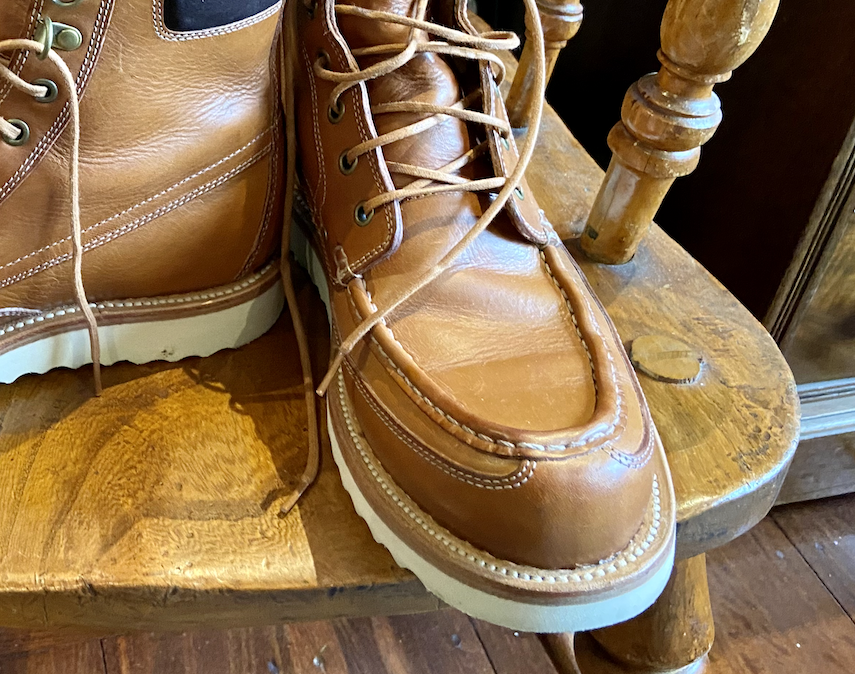
OK, that needs some unpacking.
First, moccasins are the footwear originally made by Native Americans, where one piece of leather wraps under your foot, and is then sewn onto the vamp piece with the moc stitch around the top of the vamp.
There are many mock moccasin boots.
The Red Wing classic Mac toes, Thorogood’s Moc toes - all of these have that stitch, some are really sewing two pieces of leather together, others merely mimic the stitch to raise the leather there in a roll, and yet others, like the Alden Indy, are clearly just a cosmetic stitch without even raising or puckering the leather around the vamp. Grant Stone themselves do a moc toe in their Brass Boot. Genuinely moccasin constructed boots have a single piece of leather wrapping under the foot and sewn onto the apron piece, but then a more hardy outsole is attached and sewn to the bottom.
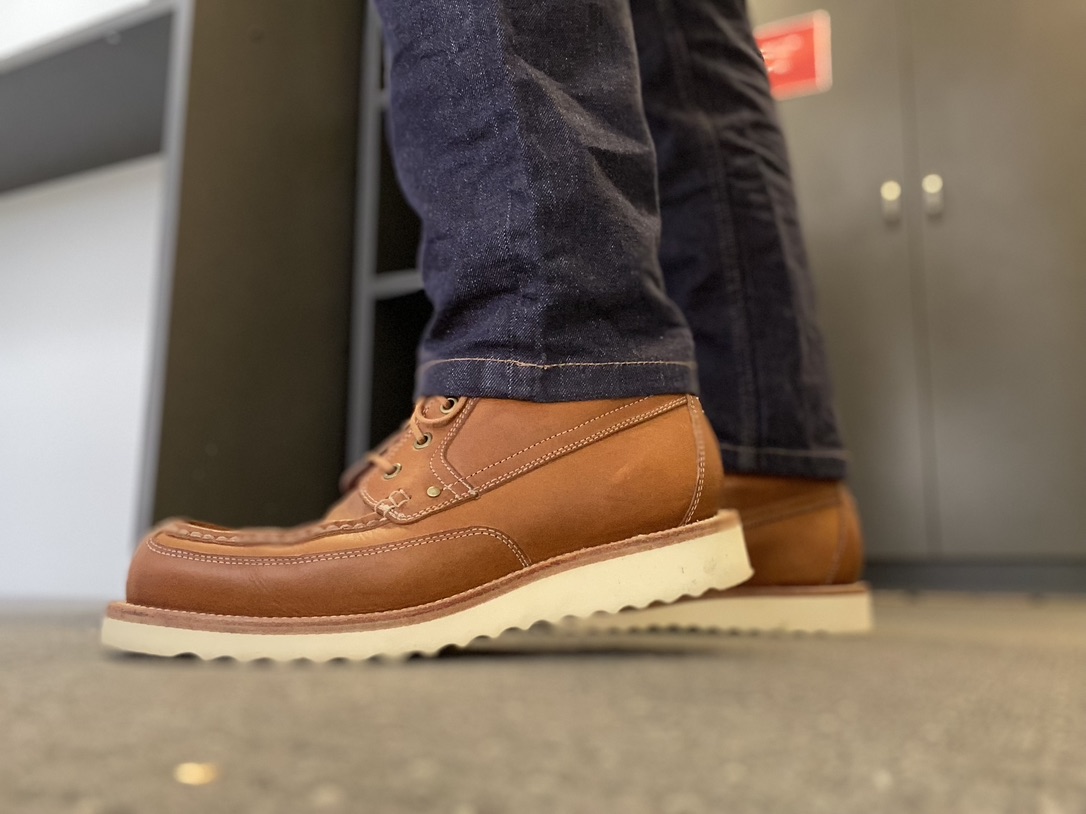
These Field Boots have the look of that classic moccasin construction with the other panels around the bumper, but these are constructed using the Goodyear Welt form of construction. The three hundred and sixty-degree welt attaches to the uppers and insole on the inside of the boot, and is stitched to the midsole on the outside. The rubber wedge outsole is then glued to the midsole. Inside is a cork filler and a steel shank, even though I’m never sure why wedge sole boots need shanks.
The uppers are tough veg-tanned leather from Badalassi Carlo in Italy. They are known for their traditional tanning methods, rotating hides in a vat or Bottali in a liquor made from tree bark. This is their premium grade full grain leather that, while having the firm feel of veg-tanned leather, still has a supple feel to it.
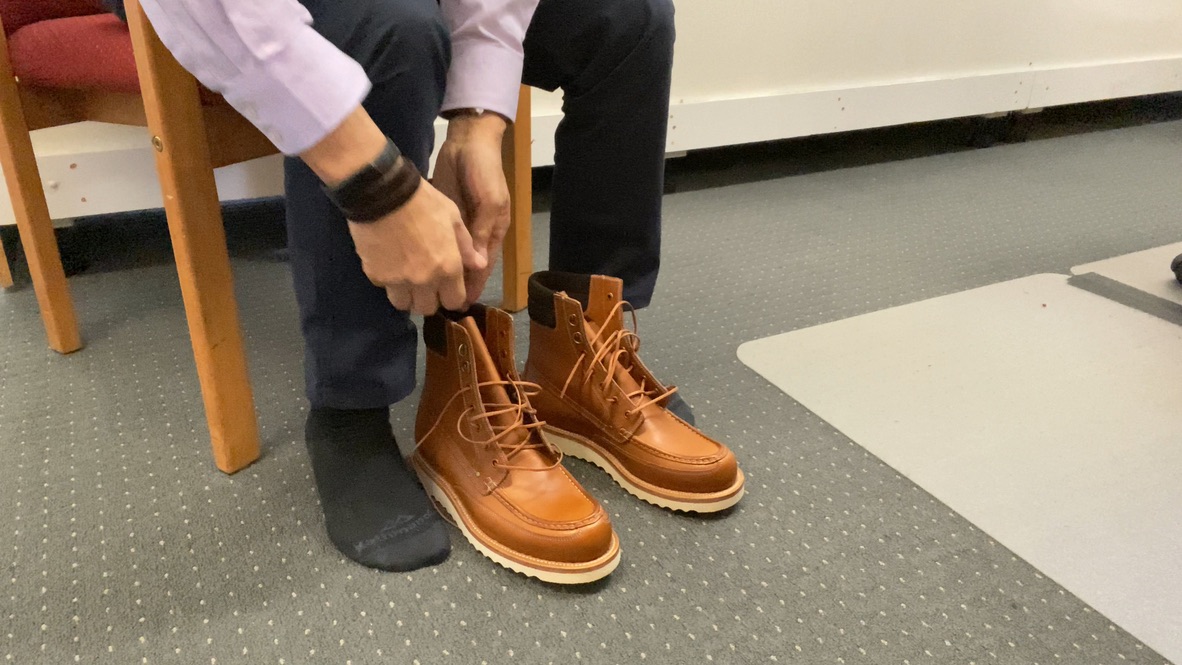
When new, it has a bright orangey colour, but as it gets wet and patinas with use, develops into a deep caramel tan. This pair was oiled with liquid mink oil before I went on my vacation because I knew they would be subject to wet, muddy conditions, and they did darken a shade because of that. Under normal conditions, with a conditioner like Venetian Shoe Cream or Bick 4, this shade won’t start appearing until at least a year, as happened on my Diesel boots in this leather.
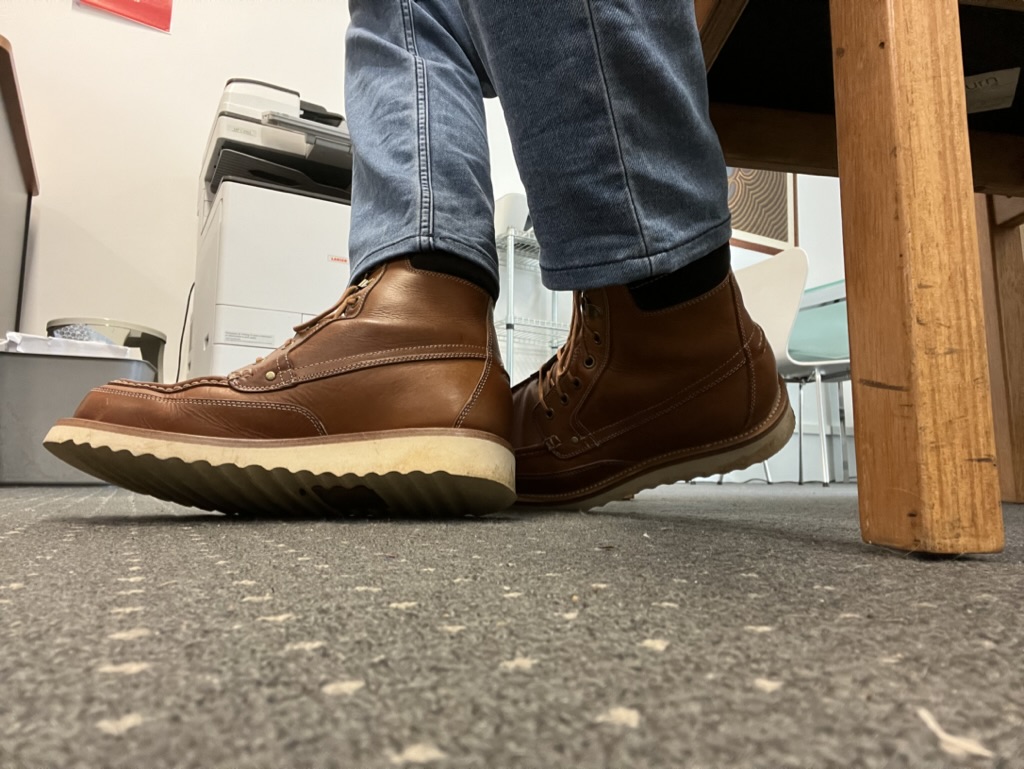
I don’t mind it - I prefer the slightly muted effect of the oil and the water on it.
The design is a moc toe - hence the stitching around the apron. It looks like two pieces of leather - you can see the top vamp piece being hand-stitched over the side wall, showing the flap that’s stitched down. The quarters are sewn on top of a boat-shaped piece of leather that goes around the boot, adding to the “real” moccasin construction look. There is a piece of leather bumper across the toe but it isn’t a real toe bumper. It’s sewn onto the side piece rather than on top of it as a second piece of leather, rather like a false toe cap. There’s a single piece backstay with a puckered stitch, further increasing the look of a hand stitched moccasin style.

Inside the heel is a leather heel counter, which in this case, feels really stiff and supportive.
The quarters provide a 7-inch shaft, 8 if you measure from the bottom of the heel. At the top of the shaft is a padded collar of suede. The padding is very light, not like the padding at the top of a Timberland Classic yellow boot. It’s not bad in use, it does reduce the rubbing on the back of your leg if the shaft was all firm veg-tanned leather. What it doesn’t do, unlike the Timbs, is to provide a waterproof seal if you cinch the lace up tight.

The skinny laces provided go through five brass eyelets and two D rings at the top. The laces are skinny, and difficult to cinch up because they slip backwards against the hardware as you tighten them and before you tie them. They are a bit of a pain to lace up because of that and because of the floppy D rings. I have tried putting leather laces through but they don’t look right somehow, like the balance is off. I haven’t tried thicker Paracord laces and that might work better.
HOW THEY WEAR
In the short number of times I’ve worn them (this blog was written in 2022 after I had them for 3 months), I have worn them reasonably hard. I first wore them every day for a week, and then every second day for another week to break them in. That was in an entirely urban situation, wearing them to go work in my office and to go to the shops and around the parks near my home. Breaking them in was no problem aside from the usual extra flexing required for wedge sole boots. Apart from the centimetre-thick wedge at the flex point, the welt is about 3 or 4 millimetres thick and the veg-tanned midsole is also about 4 millimetres thick. So getting them to flex where my feet flexed was, as always. something you need to work on when breaking in wedge sole boots.
Then I spent a period of about a month wearing them at least 3 or 4 times a week, but not always for a full day, when I worked in my yard or to go for long walks in different terrain around my suburb, to a journey through Kings Park - a bush reserve nearby - or through some of the walks available near me that had rocky, sandy and limestone gravel paths.
The boots went through that well. They were a little uncomfortable as work boots, digging holes in the garden or kneeling on the roof cleaning gutters because they were stiff, but I might put that to not being totally broken in at the time.

Initially, taking them for long walks was also uncomfortable because I really felt the stiffness in the leather and cork sole combination under my feet, but after a few walks of a GOOD duration that seemed to settle down.
In my usual half-down-from-true-size 8, these in their Floyd last are roomy and I think I could have got away with another half-size down. The extra volume added to the discomfort on long walks but after adding a thin foam insole, that was fine. Then I spent another month breaking in other new boots, but I did always pull these out when my wife and I went for our Sunday hike through the National Forests south of Perth so add to the experience 4 or 5 days of 6 to 7-hour walks in dry but mushy forest trails.
Finally, I took them on a vacation to our Southern Forests in our South West, in the wet winter we had this year. They were used most days out of the 10 days as daily wear whenever we went to the nearest town or, well, into wineries. But I also used them extensively in 4 day-long hikes we took through parts of the Bibbulmun track - a long forest and coastal track through that part of the world. In those, they went through really wet forest trails in the rain and got totally wet and soaked on most days.

And, my report is they did not let a drop of water in. I didn’t swim across a brook, but two-inch deep streams were not a problem, and I had to jump/splash across a flow of water caused by the rain and nothing got through. As hiking boots, big tick. QC after three months use like that? Also big tick. Nothing came loose, nothing split, no loose threads or stitching.
CONDITIONING
I suppose I should tell you about conditioning. I did not condition these when I first got them, but after planning our vacation, I oiled them with liquid mink oil just before we left. Yeah, I know, of course, that will darken the leather, but I was more aware of the waterproofing they would need. They darkened, but I don’t mind - as you can see, I call them mellowed rather than darkened.
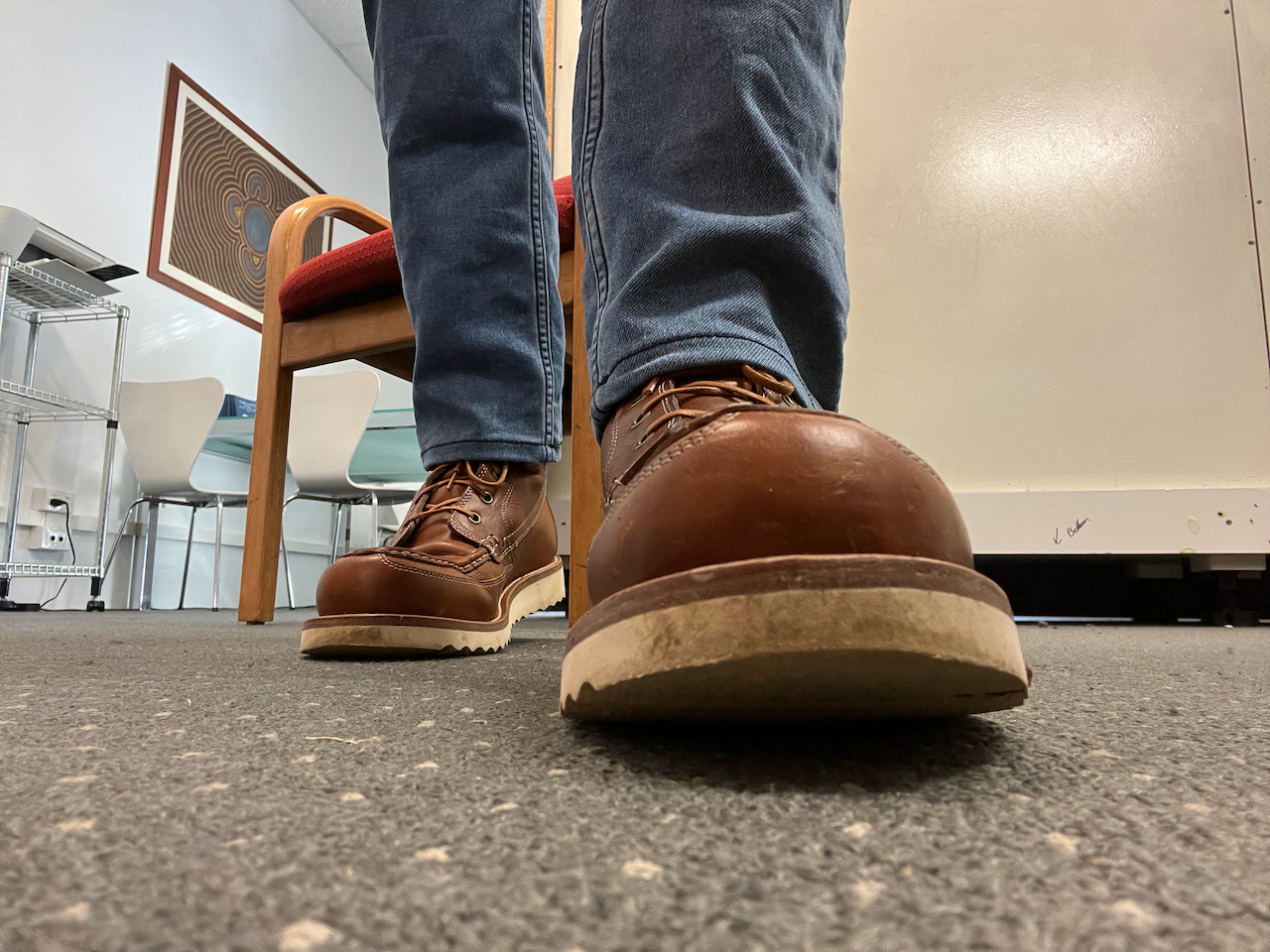
After the deluge, I just wiped them clean with an amp rag, brushed the remaining dirt off when dry, and then gave them a coat of Venetian Shoe Cream. The VSC got absorbed pretty quickly so I guess they needed it. A second coat was applied, and then brushed off with a good-quality horsehair brush.
If I (A) did mind getting them darkened and (B) did not intend to use these as proper "Field" Boots, I would have just stuck with VSC from the very beginning.
SUMMARY
To summarise, good boots!
Good quality out of the box, good quality under more pressure than many of my boots. The outsoles have worn well, except for the Grant Stone embossed leather patch under the instep - that’s been scratched and really looks ugly - not sure why they bothered to put it there.
Good comfort during and after break-in.
Wedge soles are comfy but, two cons there. Firstly, they can be slippery in muddy clay. I don’t think the corrugated pattern is deep enough to dig in, or perhaps being all in one direction could have made them slippery in that direction. Second, if you get mud in the troughs of the corrugations, wiping your feet on a mat to clean them before you go indoors is not a quick task. Wiping your feet on a door mat the usual way, i.e. dragging your feet backwards, does not work and you have to do a shimmy to drag your feet sideways in line with the ridges. Sounds silly, I know, until your wife notices the muck you’re bringing into the house.
As a work boot, the Thorogood wedge sole and Red Wing’s Traction Tred are really good for removing dirt as you walk in and out of a construction. These would not be good for that.
As to long-term value - I’m confident I can put these through a hard time and they will stand up well. Already a good price for such a well-constructed boot with Badalassi tanned leather at under US$400 when competitors might well sell these for a hundred more, they’re clearly going to last the long game, making cost-per-wear economical.
Stay connected with news and updates!
Join our mailing list to receive the latest news and updates from Bootlosophy.
Don't worry, your information will not be shared.
We hate SPAM. We will never sell your information, for any reason.

